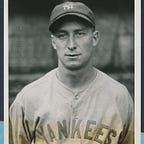Monday, June 20, 1927: New York City
“Every Day”
 Saturday afternoon Hugg hands me the ball for my third start of the season, this one against the St. Louis Browns, a lousy club in second-to-last place and whose official team motto should be, “Thank God for the Red Sox.”
Saturday afternoon Hugg hands me the ball for my third start of the season, this one against the St. Louis Browns, a lousy club in second-to-last place and whose official team motto should be, “Thank God for the Red Sox.”
I take to the hill with a record of 5–1 and a 2.14 ERA.
Five and two-thirds innings later — pitching through a constant drizzle — I leave the game after giving up eight hits and four earned runs, with a 6–4 lead.
Upset with myself for my mediocre performance and my inability to finish the game, I take a seat alone at the far end of the dugout. Benny comes over to see how I’m doing.
“Go away,” I tell him. “I’m praying.”
“Are you serious?” he asks.
“Yes, I’m serious. I’m praying. Go away.”
“Just last week you told me ‘God is dead.’ You’re not allowed to pray.”
“You’re disturbing my prayers. I’m dead serious. Go away.”
“What the fuck are you praying for?”
“For a downpour,” I tell him, irritated almost as much by his questions as by my pitching. It’s been threatening to pour all day, and if instead of this miserable drizzle the skies would drop some serious rain, the umps would call the game and I’d be 6–1 — despite my mediocrity.
My prayers go unanswered and the game goes the full nine innings. In God’s absence, Cy Moore saves my soul by stifling the Browns for the rest of the game, and we win 8–4.
Naturally, as soon as Cy gets the last out, the heavens open up and it pours down in buckets.
In the locker room after the game, I’m still annoyed with myself when Ford Frick, the math professor of the press box, drops by my locker and tells me, “You know, in your last 14 innings you’ve walked 13 out of the 66 batsmen you’ve faced. That means you’ve walked 20 percent of the batsmen you’ve pitched to.”
“That’s a good point, Ford,” I politely tell him. “Just imagine how many batsmen I could walk if I pitched more often.”
(Batsmen? What year does Frick think this is, 1897?)
Forty five minutes later, Schoolboy and I are heading out of the stadium and it’s now coming down in double buckets. Without umbrellas we race across the parking lot to Schoolboy’s car. Just before we get there, he screams, “Jesus Christ! Where are my keys?”
Then, as if we’re suddenly in the middle of the Battle of the Somme, he shouts, “Retreat! Retreat!”
We quickly scramble back inside the Stadium. We couldn’t be more soaked if we’d been standing for 10 minutes in front of an open fire hydrant. Skipper the security guard asks us, “What happened?”
“I forgot my umbrella,” says Hoyt with a straight face.
Two minutes later, Schoolboy returns from the locker room with his car keys and an umbrella. On our way out the door he hands Skipper the umbrella and we leisurely stroll to the car as the rain pounds on us, soaking us to the bone.
Before Schoolboy starts the engine, he reaches into his pants and digs out a new pack of cigarettes. “It’s the only thing on me that’s dry,” he says.
We sit and smoke for a couple of minutes, two puddles in clothes, listening to the rain hammering the roof of the car.
“There’s no way the field will be dry enough to play tomorrow,” I say to Schoolboy.
“I was scheduled to go Monday, and Hugg had Shocker on the mound tomorrow,” he says. “This monsoon will push me back till Tuesday.”
“I guess that means…” I leave the sentence hanging in the smoke-filled car for him to finish.
“Tonight we search for the sunrise,” says Schoolboy with a smile.
 Schoolboy drops me back at Steven’s townhouse to dry off. Stanwyck is in the kitchen mixing a liquid dinner for Steven and a young flapper that I’ve never met before but who, as of a few minutes ago by the looks of it, is now an intimate friend of Steven’s.
Schoolboy drops me back at Steven’s townhouse to dry off. Stanwyck is in the kitchen mixing a liquid dinner for Steven and a young flapper that I’ve never met before but who, as of a few minutes ago by the looks of it, is now an intimate friend of Steven’s.
“Schoolboy and I are starting our night out at the Ren,” I tell them. “Eyre Saitch and his boys are playing.”
“Who are they?” Steven asks. “I’ve never heard them play.”
“You mean,” I correct him, “you’ve never seen them play.”
I explain that Eyre Saitch is one of the starting players on the Harlem Rens, a Negro basketball team that holds their home games at the Renaissance Casino and Ballroom, up on 138th street in Harlem. Saitch and I met last year through Benny Morton, when Benny was playing a late show there with Fletcher Henderson’s band.
The Renaissance Casino is one of the two best ballrooms in Harlem, the other being the Savoy. Both are home to great bands and dancing till 3:00 a.m., but on Saturday nights at the Renaissance, before the dancing begins they’ll often have a basketball game featuring the Big Five, as the Rens are also called. Whenever the team plays they pack the house, and then the whole crowd stays for the dancing after the game.
“No jungle safari for us tonight, Tommy,” says Steven, squeezing his new girlfriend. “We’re heading south for a gay night in Greenwich Village at Barney Gallant’s club. His pansy shows have become the Ziegfeld Follies of drag.”
“I don’t get it. Why do you want to see men dressed as women?” I ask. “Wouldn’t you rather see women dressed as women?”
“Actually,” says Steven, “I’d rather see women undressed as women.” And with that he and his too young flapper head back to his bedroom.
Stanwyck stays in the kitchen, examining her pitcher filled with olives, gin and who knows what else, like a chemistry professor concocting a new compound. On the table in front of her are a half dozen bottles with which she’s been diligently working. She holds the elixir up, so that it covers her face, magnifying her blue eyes.
“Fish have such a blurry view of the world,” she says sadly. “Do you think they ever get thirsty?”
“If you take them out of water, I guess.”
“I bet that’s why fish die on land. They die of thirst. But don’t you worry about it, I’m not gonna let that happen to us.”
With that, one of her blue eyes winks at me and then swims away as she lowers the pitcher to pour me a long-stemmed glass of…
“Wowzer! What did you put in this?”
“My dear Tommy,” she says. “I have absolutely no idea.”
 A little before ten, our taxi pulls up to to the Renaissance Ballroom and Casino.
A little before ten, our taxi pulls up to to the Renaissance Ballroom and Casino.
Although the ballroom is a black and tan venue, the crowds for the basketball games are almost all black, especially when the Rens are playing another colored team, as they are tonight. Schoolboy, Stanwyck and I are the only whites as the game begins — three white faces floating in a very dark sea. It’s a strange feeling. Uncomfortable. Foreign. I wonder if this is what it feels like for them when they come downtown. I can sense that Stanwyck feels uncomfortable, too.
Schoolboy has snagged us three seats under one of the baskets. Hoyt’s a terrific basketball player, himself. After the 1925 season, he played for the Brooklyn Arcadians in the American Basketball League for a bit. The team went all the way to the ABL’s championship series before losing to the Cleveland Rosenblums. The ABL is all white, but their teams play non-league games against black teams, including the Rens, not only at the Casino but also downtown at the 69th Regiment Armory and out in Brooklyn at Arcadia Hall.
Probably the biggest basketball rivalry in the city is between the Rens and and independent all-white squad, the Original Celtics, led by their Jewish ball-handling wizard, Nat Holman. The Original Celtics have won most of their contests, but they’ve all been close. Wherever they play, the crowds at their games are fully integrated.
Of course, the cheering is fully segregated.
Once the game begins, Schoolboy is transfixed as he watches the Rens play play against a team from Pittsburgh, the Second Story Morrys, named after their Jewish clothing store sponsor.
“Jesus. They’re like a jazz band,” he says of the Rens.
And they are. The Big Five improvise and solo, and play with an enthusiasm that is infectious.
“They’re not just playing, they’re performing” says Stanwyck admiringly.
White ball players and white fans keep a distance from one another while the games are being played — there’s always a clear separation between us and the fans. It’s an unspoken but clear-cut arrangement: “We’re the ballplayers. You’re the fans. Thanks for your applause and support — we’ll talk to you after the game.”
Colored players, though, connect with their fans during their games in an entirely different way, through their joy of playing. I’ve seen it with Negro baseball teams, and it’s doubly true when the Big Five play at the Ren. They don’t just play for themselves, they play for the crowd. They play with a smile and a wink, and a sense of rhythm — some of them even imitate the latest dance moves. They invite their fans to spiritually join them, just like the great colored jazz bands do. As a white, I can’t fully feel it. But I can see it. Hell, a blind man could see it.
The Rens may not always beat the Original Celtics but they’re far more entertaining. As for other white teams, including Schoolboy’s Brooklyn Arcadians, comparing them to the Rens is like comparing an auto mechanic to a magician.
Tonight’s game against the Second Story Morrys is a closely fought battle — and early on there is almost a real battle, as Eyre Saitch gets into a scuffle with one of their players. But it’s quickly over, almost as soon as it starts, with both players shaking hands.
At the end of the game, with seconds to go in regulation, the Rens have possession of the ball and are running out the clock, leading the Second Story Morrys in a high scoring game, 47–45. Then just before the buzzer, a Pittsburgh player steals a pass and heaves a desperation shot from beyond half court. The ball soars through the air true to its mark, then drops down and rattles around the inside of the rim before bouncing back out.
Even before the ball hits the ground the Casino’s band starts blasting Stampede, and in an instant the ballroom floor is submerged under an ocean of black bodies seeking to dance the night away. Many of them are dancing the Black Bottom, a few are doing a brand new dance they’re calling the Lindbergh hop. A couple of the Big Five grab their girls and join in, not wasting any time getting changed.
While I’m sorting out the scene, a large hand lands on my shoulder from behind. “Mr. Thomas!” I turn around and see a very sweaty Eyre Saitch. He’s a big man who deserves his nickname “Bruiser.” I introduce him to Hoyt and Stanwyck.
“Let me change and get my girl, and then we can head out,” he says.
“Let’s stay a while and dance,” says Stanwyck. And we do.
By midnight it’s clear that she is quite comfortable being a white face in a sea of black.
 Eyre Saitch and I go outside for a smoke a little before 1:00 a.m.
Eyre Saitch and I go outside for a smoke a little before 1:00 a.m.
Saitch is a remarkable man. He got the name “Bruiser” for his play under the basket, but he’s far from a thug. In fact, he’s one of the most refined individuals I’ve ever met, a true gentlemen. He’s as well read as any white I know, and as well spoken, too. And he’s a remarkably agile and disciplined athlete. Last year he won the black U.S. Tennis Championship Singles competition.
The rain has let up, so we walk out to the corner of 138th street. The lights of Harlem are radiating from lampposts and reflecting off the wet pavement that runs up and down 7th Avenue. I offer Saitch a cigarette. He politely declines, then takes out a pouch and rolls his own. Tobacco only.
“Helluva game,” I say. (It’s a stupid way to start a conversation. “Helluva game.” Like I’m some cab driver.)
“Helluva game,” Eyre laughs.
I tell him about how Hoyt called the Rens a jazz band, and how Stanwyck loved not just their play but their performance.
“I enjoy watching us play, too,” Eyre says smiling. “Some nights it feels as if, instead of playing on the Big Five, I’m playing with Armstrong’s Hot Five.”
“Things got a little hot out there tonight. What happened with that scuffle?” I ask.
Eyre takes a drag on his cigarette. I can tell he’s thinking about how to answer my question. Enough time goes by that I figure I might as well just move on, so I ask him if he wants to go back inside.
“One of my brothers on the other team called me a word that I consider wrong, coming from any man, no matter the color of their skin.”
“But I hear Negroes calling each other n*gg*r all the time,” I say.
Eyre looks wounded.
“It’s a horrible word. I will not have it directed at me.” He pauses. “If I can help it.”
“How often does it happen?” I ask him.
“That I’m called a n*gg*r? To my face, not often, but that’s just because of my size. I hear it every day. And I don’t have rabbit ears.” He smiles at me. It’s a kind smile. A wise smile. A smile filled with pain.
“I hear it every day, Myles. And I feel it every day. I may not be able to educate the policeman on the beat carrying a gun and a billy club, but I can certainly educate a brother on the court.”
“How often do you say it?” he asks me.
“Not a lot.” I’m being honest.
“How often do you hear it?” he asks.
“Every day,” I say. “A lot of times it’s directed at Ruth, from the stands. Hell, Cobb calls Ruth a n*gg*r practically every game they play against each other. And the Giants and McGraw did it in the World Series, until Ruth and Meusel went into their locker room and shut them up. Most of our southern players say it. Sometimes they mean it. Sometimes they don’t.”
“They always mean it,” Eyre says. “They always mean it.”
Back inside we go looking for Schoolboy and Stanwyck. Before we find them, Eyre’s met by one of his teammates who says that he’s heading over to a rent party a couple of blocks away, on 140th street. “Really? You bringing the Ofay?” I hear his teammate ask Eyre, looking at me, before shaking his head and walking away.
Eyre gives me me an apologetic look.
“At least he didn’t call me a n*gg*r,” I say. And we both laugh.
We find Schoolboy and Stanwyck, and along with Eyre and his girl the five of us head out to the party.
 There’s a different energy in Harlem at night than exists anywhere else in the city. Part of it is the landscape, with its wide boulevards and low buildings. You can see the sky wherever you walk here, and that gives Harlem a sense of space, a sense of freedom, a sense of being in a very different part of Manhattan.
There’s a different energy in Harlem at night than exists anywhere else in the city. Part of it is the landscape, with its wide boulevards and low buildings. You can see the sky wherever you walk here, and that gives Harlem a sense of space, a sense of freedom, a sense of being in a very different part of Manhattan.
Walking in the heart of white New York, almost anywhere below 72nd street, is like walking inside a giant engine that’s constantly whirring, constantly churning out money and news and entertainment, constantly creating things to be sold, and constantly selling them as quickly as possible. But Harlem isn’t a machine. Harlem breathes. And on Friday and Saturday nights, especially in the summer, Harlem shouts with joy. It’s one of those things in life that makes no sense, since these are the people who have the least to celebrate.
Eyre walks us down Strivers’ Row, two of the most beautiful blocks in all of Manhattan. He tells us how the townhouses that line the blocks were built over 30 years ago by the famous architect, Stanford White, back when Harlem was an all white neighborhood. Blacks started moving up to Harlem from the Tenderloin district before the Great War, and it didn’t take very long for the whites to start moving out. Since the war, Harlem’s become all black.
Strivers’ Row is where the wealthiest Negroes, the ones who have made it — “the strivers” everyone calls them — now live. Many of them are entertainers, folks like Eubie Blake, W.C. Handy, Stepin Fetchit, and Bojangles Robinson. A couple of them are boxers, like Harry Wills and the former heavyweight champ, Jack Johnson. A few are writers. One, Eyre says, is even a surgeon from Harvard.
After we walk through the quiet elegance of the Row, we curl back around on 140th street, where we’re once again surrounded by a Harlem summer night. There must be half a dozen parties on this one block.
“What’s everybody celebrating?” asks Stanwyck.
“They’re celebrating the fact that they’ll be able to pay their rent for another month,” says Eyre. “Not only do Negroes get paid a lot less, we also get charged a lot more for rent, since there aren’t a lot of places where we’re welcome to live. It’s a simple case of supply and demand, with a complicated case of race mixed in.” He says this almost matter of factly. Almost.
“In order to pay the rent, a lot of folks up here hold rent parties, especially on Fridays and Saturdays. When we go inside to any of these parties, there’ll be a cover charge of a couple of bits apiece, and we’ll have to pay for our drinks, but all the money will be going to help someone pay their rent.”
We cross the street, pay our cover at the door and enter a tenement building teeming with Negroes. The smell of muggles is pungent. On the first floor there’s a three bedroom apartment, empty of furniture but full of people dancing to a three piece jazz band — piano, horn and drums. Eyre’s girl walks us through the apartment and into the kitchen. We then climb through the window and down the fire escape, dropping down into a large concrete courtyard in the back where another band is playing.
“Myles, I want you to meet someone.” Eyre walks us down to the other end of the yard and waves at an elderly gentleman.
“Myles Thomas, I’d like to introduce you to a friend of mine. Sol White.”
- Brooklyn Arcadians
- BENNY Bengough
- Original Celtics
- Harlem Rens
- WAITE Hoyt
- Second Story Morrys
- BENNY Morton
- Eyre Saitch
- Barbara STANWYCK
- STEVEN
- Sol White
- Stanford White
- 1927 Yankees
- June 18, 1927: “Gehrig’s 2 Homers, Triple Beat Browns”. New York Times article and Box Score.
